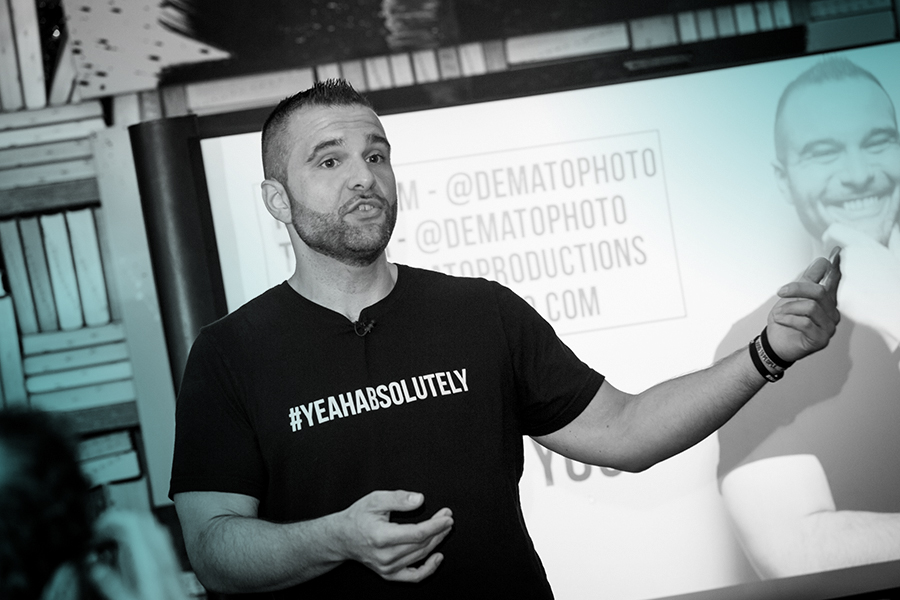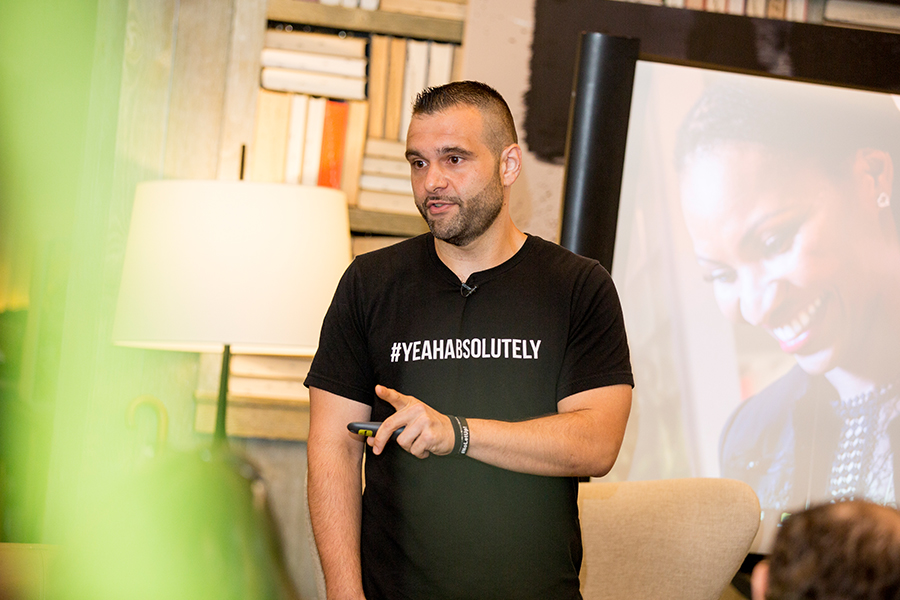@MichaelVernazzaPhoto
Don’t let the term, “Branded Content,” intimidate you. This just means content that reflects either your personal brand or what your business offers, whether that is service or product. As you might have figured out, branded content, if done well, can be deployed as a highly effective tool for your lead generation.
For my August meetup event, I invited back branding & lifestyle photographer, John DeMato from DeMato Productions, to tackle two commonly known obstacles associated with the content creation process for businesses.
How to stay consistent: While we all know consistency is key when it comes to content creation, it can be challenging for business owners whose main job is to run their businesses,
How to keep your content interesting & engaging: Often, when we focus on generating interesting & engaging content, we face “performance anxiety.” As a result, we ended up posting something sub-par or not posting at all.
John appeared at my November event last year entitled, Make Your Mark: A Winning Strategy that Translates Your Brand. This fireside chat was well received among my members, so it was a no-brainer for me to bring him back on the subject of content creation for entrepreneurs.
Because I wanted this event to focus more on “how-tos,” John put together a value-packed masterclass.
Is this You?
“It all started from one client whom I’ve taken so many great photos for,” said John.
“Later I found out this client ended up not using the ones I have taken and used some stock photos instead.”
This is not because the client wasn’t satisfied with John’s photos. It was that she did not know how to use those images in her content strategy. She couldn’t connect the dots between the stunning images John took and her brand story.
This challenge isn’t unique. I have personally faced this situation on numerous occasions.
John realized he could help his clients not just by offering branded photos (and creative direction needed to produce them), but with assistance in taking it one step further, to utilize them in the most impactful way.
“I hear these all the time from my clients.”
John is talking about three excuses people have for not keeping up with their content creation effort and not posting consistently on their social media and their site.
Are you ready to find out what they are?
“I don’t know what to post on days I haven’t done any client work.”
This comment stems from the deep-rooted belief that you should only post about what you do in your business in real time. So, if you haven’t done any client work, you have nothing else to talk or post about.
“This is not the case at all. Actually, this is the best time to curate and plan out your content,” said John.
Not everything has to be posted in “real time.”
Some are already familiar with social media scheduling tools such as Hootsuite, Buffer, SocialJukebox, and MeetEdgar.
When you are not too busy with your core business, you can clear your head and work on how you want to curate your content throughout the week (or for the entire month.)
John shared, “I am 2 months ahead with my content.”
“But it wasn’t always like this. I have been consistent for about a year now.”
“Sometimes, I stress all day about what to post, then throw something up because I feel like I have to post something every day.”
This is the case of “performance anxiety.”
It makes the matter even worse by stressing over what to post. The stress paralyzes your creative thinking, so you are left with more anxiety and no posts.
John shared that, “In that moment, you might as well not post anything because whatever you decide to throw up will not be aligned with other content you have posted, there is no continuity. So, you end up sending mixed messages, and that can be a turn-off to your audience.”
Oh dear. This is serious.
At this point, I sensed everyone in the room was realizing how curation and planning must be put in place to make it happen. This was recurring theme of the night, and John made this point very clear from the beginning of this masterclass.
“My life is boring. What am I supposed to write about (other than what I do)?”
While “over-sharing” is a big no-no in the world of professional social media, it can be paralyzing to not know what to post. Either they are unsure what to post outside of their work, or they are holding back and not sure how “vulnerable & personal” they can be without crossing the line.
I truly sympathize with this one. I doubt clients really believe that their life is boring. It’s more that they are stuck in self-editing mode because they don’t know how much sharing is appropriate for their business.
John talked about how looking beyond “what” and “how” to dig deep with “why.”
Here are some helpful questions to get on-brand posting inspiration:
“Why do you do what you do?”
“When are you energized during your work?”
“What is your favorite moment when you serve your clients or customers?”
Your answers to these questions will likely include some examples and stories, and that is where you need to be with your content. This way, you don’t have to be concerned with crossing the boundaries. Instead, through your personality and stories, you will convey the reasons your audience should work with you without mentioning it.
John’s story of quitting his job four years ago, which he shared at the event, perfectly illustrates this point.
As a portfolio-driven photographer, he was positioning & operating as a transactional business. In the beginning, he was posting his work with no captions or stories behind those headshots.
It was a hard sell because, although the images were beautiful, they did not act as a bridge between his capabilities as a photographer and how his prospects would feel if they were to work with him. This is the gap many business owners can relate to, and this is one of the reasons why, even if they post consistently, they don’t get much traction.
John now has shifted his approach to provide value through his content. He incorporates his own stories and unique point of view that people gravitate towards. His photographs act as the “visual punctuation” to accentuate his content, instead of just letting pictures speak for themselves.
In John’s words, the ultimate goal of your content should be to make people feel like, “I care about this person beyond what he or she can do, and I want to follow them.”
@MichaelVernazzaPhotography
4 Steps to Generate Consistent Content Ideas that will Convert into Valuable & Memorable Social Media Content
Here is the simple, four-step process John mapped out, which he actively uses to help his clients achieve consistent content creation.
Step 1: Belief & Commitment
Believe that what you offer is important and that there are people who need your help.
“You can talk about tools and fancy images later. It all has to start from you,” said John.
If you doubt your capability or offerings, it will show. People will pick up on it. So, ground yourself with the belief that you and your services are needed, and own that feeling day in and out.
Then, the next step is to commit to a set schedule. You don’t need to post every day from the beginning. Just come up with something you can stick with.
John added, “Don’t get hung up on metrics. Don’t let yourself discouraged by it. It is not about how many likes and comments you get, especially in the beginning.”
The idea is to first get used to the idea of consistent posting so that you and your business can be top of your audience’s mind. Then, you can worry about metrics later.
Step 2: You don’t need to change the core messaging. Explore a variety of ways to convey it.
To make his point, he shared the time he spent working as a TV producer for the Maury Povich show, which featured two themes: Paternity & Cheating.
As you can imagine, this cracked people up a bit!
Episode after episode, it was all about paternity testing and cheating spouses.
Talk about running low on new content! But the show has run for 27 years. How?
It’s in unique insights (a.k.a. story points) that were crafted to create variety.
You can apply the same method as a strategy to explore different ways to convey your core message. When you just talk about what you do, you feel like you have nothing more to say. You can push yourself beyond this point to create different angles and perspectives.
More on “how to go about it” later with the example John presented.
Step 3: Have a process of taking down your ideas.
“How many of you had a moment when this amazing idea popped up while you are walking down the street or having a conversation with someone on the phone, and you felt this is going to be your break right here & right now?!”
John continued, “Then you decide to victory-lap in your head about how great this idea is, but you forget to do the one thing – write the damn thing down. And, 10 seconds later, it’s all gone!”
“The whole purpose of crafting a well-curated social media presence is to capture those unique moments, unique insights and unique thoughts.”
Active documentation of those ideas throughout the day will eliminate content block.
John elaborated that the great benefit of this practice is that you get to start from the raw and unfiltered ideas. You can scan through your list of ideas and focus on developing them systematically, instead of feeling the pressure to start from scratch
“You no longer need to work out of deficit; now you are working out of abundance.”
You now know how to open yourself up to a completely different way of acquiring content ideas.
Step 4: Create a Process that Optimizes Your Brainstorming Session
Free-writing doesn’t work for many.
“With free-writing, you are just allowing yourself to roam your thoughts to go all sorts of places (without a structure.),” said John.
Sometimes, this method can work, but often it does not guarantee consistent content creation. Instead, what you need to do is to create a process that narrows and focuses your attention.
The “Idea Nugget Generator” is the system John came up with to help his clients organize their ideas. He has a workbook that outlines several themes to sort ideas, which helps add more variety to their content. It also allows them to plan their content calendar by mixing up these themes over time.
@MichaelVernazzaPhotography
Putting It into Practice with One of the Idea Buckets
I always want my events to be as interactive & engaging as possible. John offered an idea to implement one of his “idea buckets” on the spot using our smartphones.
This was an awesome way to empower business owners who may believe all the photos they use need to be “professionally taken” (because selfies can dilute their brand). In this case, they are missing out on huge opportunities. Data shows people have more affinity towards raw footage (video) and spur-the-moment photo images. These are the best medium to showcase who you are and what you can do for them.
Pick an Object that Emotionally Resonates with You.
Why does this matter?
John explained,
“While you do want to talk about your expertise, posting something like this, something that is deeply connected with you & beyond what you offer, will build rapport with your audience.”
“This opens up a conversation with your audience. Now they see you in a different way. They see you as a human, they see you as someone they want to invest their time in, and they want to trust you.”
This is an easy practice that everyone can plan ahead of time and incorporate into their social media feed.
John first shared a perfect example of this method by showing a photo he took for one of his clients, Shir, an Excel Instructor. The image connects his approach of breaking down something complex (Excel) to a step-by-step process, just like the way you play with Rubik’s cube. In the end, Shir empowers people to make the complex simple.
@MichaelVernazzaPhotography
That is the story behind this image, and Shir can now use it to explore valuable branded content.
Do you see the difference?
Isn’t this far from what you thought your content should look like?
That’s the whole point. An image like this may look like it has nothing to do with what he offers. But, there is a common thread between the way you can systematically solve a Rubik’s cube and the way Shir teaches his clients to approach Excel.
This sounds like a relatable and approachable story, doesn’t it?
Once John made this point clear, we moved on to put this method into practice by using our smartphone to snap an item we care about, and here are some results:
We all have stories to tell through our favorite items.
This was a fun & resistance-free way to get our feet wet for more creative ideas.
Key Takeaways
While there were golden nuggets coming out of John’s mouth every minute, here are the key takeaways to rewire your old thinking about content creation.
Ideas don’t get generated by sitting at the desk.
Capture, capture, and capture your raw ideas that are free from overthinking.
Having idea buckets can help you organize your ideas.
Once again, a million thanks to John for the evening. You can learn more about his projects and courses that can help you revive your content creation process here. He is, as you guessed, very active on all social media platforms. My favorite place to see his work, hands down, is on Instagram. I encourage you to follow him so that you can use it as the source of inspiration.





